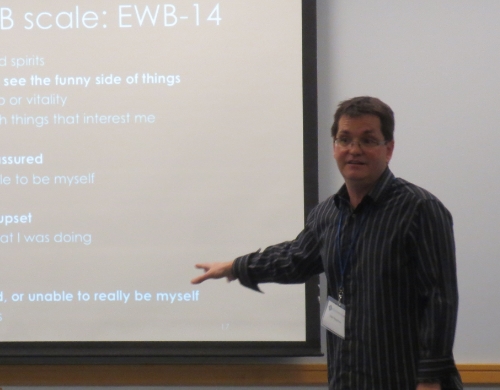The first St. Louis Area Well-Being Workshop was held at Saint Louis University was held on February 26, 2016.
Presentations:
"Black Women and Girls' Return to Joy: Healing from Trauma"
Dannielle Joy Davis (Education, Saint Louis University), with Cassandra Chaney (Louisiana State University), Denise Davis-Maye (Auburn University, Montgomery), and Donna Culbreth (National Girls and Women of Color Council, Inc.)
Abstract: The concept of thriving amidst trauma receives minimal attention when addressing negative life experiences of Black women and girls. This work examines strategies employed and recommended by Black women and girls that prompt thriving amidst traumatic circumstances. Radio broadcasts from the National Girls and Women of Color Council serve as data for the topic. Findings reveal the strength of Black women and girls in dealing with trauma, holding the potential to move beyond coping with circumstances, towards potential thriving.
"Happiness Metrics for Policy"
Dan Haybron (Philosophy, Saint Louis University)
Abstract: I discuss the case for bringing happiness metrics into policy evaluation, suggesting that greater attention is needed to deploying "emotional well-being" measures. I briefly outline some key features we should want in such measures.
“Eudaimonic Well-Being: What Is the Right Way to Think About It?”
Kennon Sheldon (Psychology, University of Missouri-Columbia)
Abstract: I argue that positive psychology and well-being researchers have gone off the deep end in their embrace of the term “eudaimonic well-being” (EWB), creating deep confusion in the field. I will propose a solution wholly consistent with Aristotle’s original understanding of eudaimonia: The “Eudaimonic activity model” (EAM). The EAM distinguishes between conative activity, which may or may not be eudaimonic; satisfying experiences, which may or may not result from conative activity; and subjective well-being (SWB), which reliably results from truly satisfying experiences. I review research consistent with this model, and argue that SWB offers the best or one of the best criteria for distinguishing between eudaimonic and non-eudaimonic activity. Pursuing SWB directly does not work, but pursuing eudaimonic activity does, bringing (as a side effect) many satisfying experiences, which in turn bring SWB.






